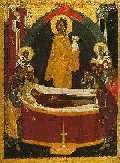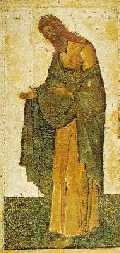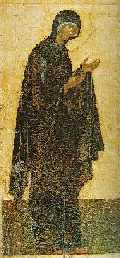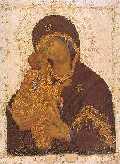





Theophanes the Greek. From left to right: The Dormition of the Virgin (1392); John the Baptist and The Virgin (from the Annunciation Cathedral in the Moscow Kremlin -- 1405); The Virgin of the Don (1392). The Dormition of the Virgin and The Virgin of the Don are painted on both sides of one panel.
Theophanes the Greek is believed to have been born in the 1330's and to have died sometime between 1405 and 1409. He had been well read in religious literature and art before his arrival in Novgorod around 1378. During his self-contained, quiet, short-lived stay in Novgorod, Theophanes painted famous murals in the church of Transfiguration on the Ilyin Street. His works are also present in the Church-on-Volotovo-Field and in the Cathedral of St. Theodore Stratilates. After working in Kostroma in 1390, Theophanes moved to Moscow in 1395 as it was entering a new stage of history attempting to lead Russia to unification of divided lands and to the end of the Mongol yoke. Theophanes' first Muscovite work was the Book of Gospels of Boyar Koshka, for which he painted miniatures and which would later be used as the basis of the Khitrovo Gospels. Although Theophanes must have painted many icons throughout his life, scholars believe that the following nine are indisputably his: The Dormition of the Virgin, The Virgin of the Don (both 1392) and The Saviour in Glory, The Virgin, St. John Chrysostom, Archangel Gabriel, St. Paul, St. Basil, and St. John the Evangelist, all of which were painted in 1405 for the Deesis tier in Moscow's Cathedral of the Annunciation.
The fame of Theophanes in Moscow was so great that Epiphanios the Wise, a famous 14th-15th-century writer who knew the painter well, felt compelled to describe in a letter to his friend the master's method of work, apparently quite extraordinary at the time: "When he was drawing or painting . . ., nobody saw him looking at existing examples, as would do some of our icon painters, who would constantly stare at them with amazement, looking here and there, doing less of actual painting than looking at examples. He, on the contrary, appeared to paint his frescoes with his hands while walking back and forth, talking to the visitors, considering inwardly what was lofty and wise and seeing the inner goodness with the eyes of his inner feelings."
Theophanes had invited Andrei Rublev to assist him in the painting of the murals for the Annunciation Cathedral, and in the process had done wonders to develop Rublev's genius. However, Rublev would later break away from Theophanes' dramatic severity of form, color, and expression, and become one of the greatest masters of Russian icon painting. Theophanes' beautiful colors and pure forms made him a remarkable artist who played a great role in laying the foundations of mature Moscow icon painting. [S.H. and A.B.]
